Digital marketing is marketing that makes use of electronic devices that marketing professionals can use to deliver promotional messaging and track its effectiveness throughout the consumer journey. Digital marketing refers to marketing initiatives that display on a computer, phone, tablet, or another device in practice. A few examples are online video, display ads, search engine marketing, paid social ads, and social media posts. Traditional marketing methods such as magazine ads, billboards, and direct mail are frequently compared to digital marketing. Surprisingly, television is frequently grouped with traditional marketing.
Digital marketing, often known as online marketing, promotes brands through the internet and other digital communication to engage with potential clients. As a marketing channel, this comprises email, social media, web-based advertising and text and multimedia messages.
The digital marketing principles listed below can help you develop efficient and cost-effective business strategies.
Content is king
A good digital marketing plan will distance itself from the competition by focusing on high-quality, interesting, and shareable content. Customers expect you to give them what they want to understand your product and do business with you.
Keep it simple
Advertisers have long recognised that the strongest message is a basic one. Communicators must be brief while writing for the web. Customers will only give you a limited amount of time to interact with them as the digital realm becomes increasingly crowded. Make efficient use of words, visuals, and technology.
Set defined goals while experimenting with digital marketing methods. For example, the number of emails per month or conversions is done via email and blog. Every marketing goal you establish for yourself should be measurable. You do not have to establish absolute targets, but you should have a figure in mind and keep track of everything each month.

Keep on moving forward
The digital world continually evolves, with new platforms, trends, and technologies appearing almost annually. As a result, your digital marketing strategy must develop as well. You must commit to always striving for improvement and growth. If you do not want to be left behind, you’ll have to invest time and effort into anticipating or inventing your own trends.
Know your customer
You must grab your customer's attention by communicating directly and simply. You miss your mark and market if you do not target your unique audience. To learn more about your target audience, you can use various technologies. The most popular is Google Analytics. It can help you figure out your demographics and target audience.
Be optimised for mobile
If you do not have a mobile-friendly website, you are missing out on many prospective customers. Mobile browsing has now exceeded desktop browsing in terms of market share. People are easily upset when they have to zoom in and out repeatedly to get the information they need.
Nurture marketing relationships
A successful marketing partnership has a long-term customer relationship. Creating a network where people associate with a brand that feels natural, honest, and trustworthy improves revenue and promotional predictions.
New forms of digital marketing emerge all the time, so staying ahead of the curve is critical for any creative marketer. Overall, it is crucial to remember that digital marketing is a rapidly rising force in the present marketing landscape. It will soon be the future of marketing as digital media replaces more traditional marketing methods.
The key to successful selling is what advertising and marketing experts refer to as a "unique selling proposition" (USP). You cannot successfully target your sales efforts unless you can pinpoint what makes your firm unique in a world of similar competition.
What is a unique selling proposition?
A unique selling proposition (USP) distinguishes a company and its products or services from the competition. It is what they offer that no one else in the market does, whether it is greater quality, a lower price, a better customer experience, or a new technological advancement.
By carefully analysing other companies USP strategies, you can learn a great deal on how to distinguish your business from the competition and persuade the customers that the product or service that you are selling has better characteristics. For example, Charles Revson, the founder of Revlon, claimed that he sold hope rather than makeup.
Here is how to uncover a business’ USP and persuade the customers to boost sales.

Put yourself in the customers' shoes
Take a step back from your day-to-day activities and consider what your customers desire.
Assume you are the owner of a pizza business. Customers do come into your pizza parlour for the food. Is it true that all they want is food? What could entice customers to return time after time while ignoring your competitors? Quality, convenience, dependability, friendliness, cleanliness, civility, or customer service may be the answer.
Know what motivates your customers' behaviour and buying decisions
You need to be an amateur psychologist to promote a product effectively.
It is not enough to know that 75% of your clients are between the ages of 18 and 25 in our pizza restaurant example. You should consider their reasons for purchasing pizza, such as taste, peer pressure or convenience.
Uncover the real reasons customers buy your product instead of a competitor's
As your company is expanding, you'll be able to turn to your best source of data: your clients.
For example, a pizza business owner could inquire why they choose his pizza over others and how important the qualities he offers, such as taste, size, ingredients, atmosphere, and service, are to them. When you ask customers how you can improve your service, you'll be astonished at how honest they are.
To have a powerful unique selling proposition, your product or services do not have to be completely unique. Instead, search for an area of the market where you can plant your flag that is relatively free of competitors. There are also many ways to market your goods, but your USP is the main idea that best positions your brand in relation to what your buyers care about and what your competitors do not. There are also different platforms to your product or services that can easily persuade your customer to look into your products.
Have you ever double-clicked an image on Instagram, responded to a video on Facebook, or clicked a Google search result only to discover later that it was an advertisement? Maybe you did not realise it was an advertisement at all, you just thought it was a cute puppy photo. Ads can be contextual, relevant, targeted, and useful in ways never previously possible. In a nutshell, today's advertisements are content.
Determine your target audience for search engine optimisation
Identifying and understanding your target market is an important factor that can help you improve your search engine optimisation (SEO) approach. When your target audience notices that your content is targeted to their specific needs and that you care more about their well-being than their bank account, they are more likely to become loyal customers. With the constant updates of search engines and the increased awareness of the audience, the entire environment of SEO has changed. There are numerous advantages to establishing your target audience. It not only assists in the development of a strong SEO strategy but also increases the number of relevant visitors to your website.
Look at the following six steps to accurately define your target audience.
- Understanding current customers: create confidence between you and customer. What can you offer them?
- Define demographic of target market: Age, geography, income, occupation.
- Define competitors: Find your target audience. Check out the keywords.
- SEO keywords: Keywords are the foundation of all other SEO activities
- Analyse the SERP (search engine results page): Search keywords and see where they rank. Pay attention to the similar themes.
- Do surveys with current customers: Surveying current customers. Collect responses from your clients using tools like Google Forms.
Understanding your target audience and what content they want to consume is important to SEO success. There is no denying that keywords play a critical role in creating an effective SEO strategy. Even so, if you do not know who you are targeting, you would be able to focus your efforts and be confident that you are reaching the proper individuals and increasing your chances of converting a searcher into a customer. Another great way to boost your target audience platform searches is with Pay per click campaigns.
Pay per click
Pay-per-click (PPC) is an online advertising technique in which an advertiser pays a publisher for each "click" on an advertisement link. The cost-per-click (CPC) model is another name for PPC.
Some of the most popular types of PPC is search engine advertising and display ads. When someone searches for a keyword relating to their company offering, advertisers can bid for ad placement in a search engine's sponsored links.
Search engine ads
“Pay-per-click advertising is most common on search engine results pages, such as Google, but social media is also popular. If you are wondering where pay-per-click advertising can be found, they are the results that appear before and to the right of organic search results. Take, for example, the ad that came up when I searched for "cards."
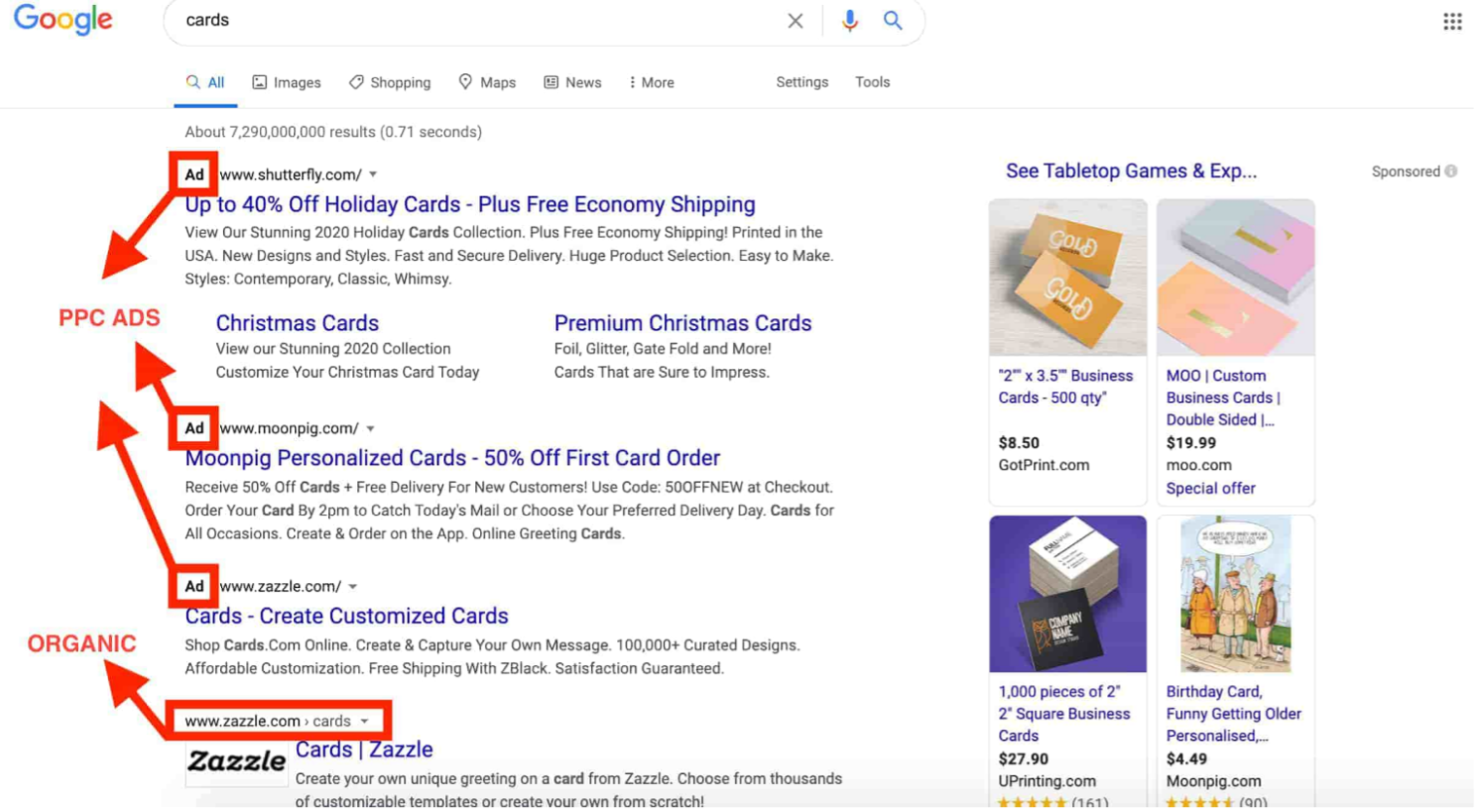
A business must pay a fee to the search engine every time their ad is clicked, resulting in a visitor to their website. When PPC is working properly, the charge is insignificant because the visit is worth more than the amount they pay.” (Wass, 2021)
Example: He got his dream job using PPC
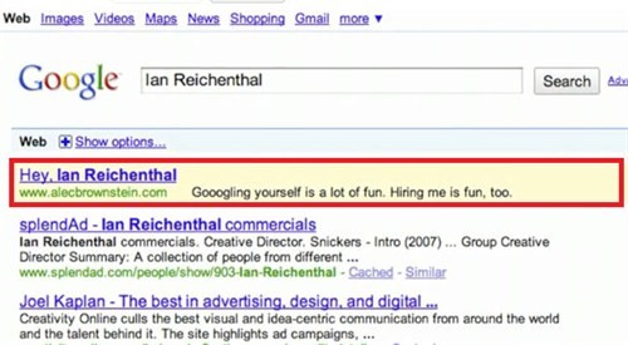
‘In 2009, Alec Brownstein was a senior copywriter looking for a new job and came up with a very creative way to attract the attention of the people he most wanted to impress.
He presumed that because most people like to search their name on Google regularly, New York’s top creative directors would too, so he picked 5 to target with his very clever idea. He bid on their names on Google Ads, and since he was the only one bidding, he got clicks for just 13 cents each. The ads linked straight to his website. The result? 4 of the five directors invited him to an interview, and 2 of those 4 offered him a job. Outstanding! And his entire campaign cost him a total of just $6! It is a fantastic example of ingenuity.’ (Wass, 2021)
Display ads

PPC is also used when showing banner advertising on websites linked to a brand's products and services or the interests of its target audience. If done correctly, these types of campaigns can be quite beneficial, but you must be careful not to fall into the trap of invasive advertising. It is also important to note that CTRs (click-through rate) are typically far lower than in other sorts of ads, demanding a broader audience.
Example: Apple TV uses simplicity to grab your attention

‘You may not need a lot of text or compelling ad copy to grab someone’s attention with a display ad. It is often much better to keep things simple, like this Apple display ad example. Just look at this leader board ad for the Apple TV gift card. They highlight the colourful cards themselves and use four words of copy in total. (Smith, 2021)
Hashtag marketing
We frequently use hashtags, particularly on Twitter and Instagram. You may have even used them on other platforms like Google+, Pinterest, or Facebook. But do you know how to use hashtags properly for better-targeted marketing campaigns?
Hashtags, when used correctly, can bring a wealth of benefits such as:
- They can be used to get your content in front of a bigger audience
- Raise awareness about your brand
- Target a very specific group of people
- Boost your SEO
- Use hot trends and topics to your advantage.
Here are six simple ways to use hashtags in social media marketing:
Not spammy but snappy
We have all seen those posts stuffed with every hashtag imaginable, and Instagram users are not as prone to hashtag fatigue as Facebook and Twitter users are. Tagging your photos and videos with the most popular hashtags will probably gain new followers.
Specific and unique
Think again if you expect people to see and interact with your content by using generic hashtags like #marketing, #seo, or #fashion. It will be like looking for a needle in a haystack attempting to spot your post among thousands of other generic posts with the same hashtags.
Look for hashtags on social media that have a narrower but more focused focus, ones that are relevant to your brand's content. The hashtag business is similar to keyword research in that it is all about finding the proper hashtag that fits your business.
Utilise trending hashtags
If you identify a trend relevant to your company, seize it and connect with it by including the hashtag in your posts. You can reach a significantly bigger audience by using a popular hashtag in your content update. This means that, rather than simply your fans and followers, a growing number of people will see your posts, and as a result, a growing number of people will re-share them, helping to raise brand awareness.
Do research
When using hashtags on social media, keyword research is essential to guarantee that your hashtag is not being used for the wrong reasons, just as it is when utilising keywords. Stay clear from contentious hashtags if you want to bring your audience together rather than split them.

Create brand engagement
It is essential to understand WHEN to use hashtags on social media. Knowing how to leverage the power of a hashtag and use it effectively is critical to its long-term sustainability. Hashtags will not work just because you want them to. They should be framed as a call to action rather than a message to succeed.
Hashtags, tone, and trust
Taking the time to carefully craft a brand image is well worth the effort, because the more comfortable your followers are with your brand, the more likely they are to try to communicate with you through it. They WILL come and engage if you create the correct content and use your well-researched hashtags.
You would not think so but using hashtags in social media opens up a world of possibilities. Learning how and when to use them correctly is crucial to gaining brand awareness. Let us now look at the different marketing platforms that one can use to get more exposure for your brand.
Any marketing strategy should aim to persuade and influence your target audience. Professional social networking is no exception, with the best social media marketing designed to encourage the audience to choose a specific path. This is no different for professional social networking, with the finest social media marketing designed to encourage the audience to follow a predetermined path. You have the ultimate power in the marketplace when you can persuade and influence others to behave in a certain way.
Social media marketing platforms
Social media marketing consists of developing captivating content for your social media profiles. By listening to and connecting with your followers, analysing your results, and running social media ads, you will connect with your audience to promote your brand, improve sales, and drive website traffic.
‘Facebook, Instagram, Twitter, LinkedIn, Tiktok, YouTube, and Snapchat are the most popular social media platforms right now. There are also several social media management tools available to assist companies to get the most out of any site. Even though earned and owned media have their own marketing value, paid social advertising is the most reliable strategy to drive traffic and purchases right away. 75% of Gen Zers and 48 % of millennials are affected by social media ads in 2021.’ (Westcott, 2021)
When it comes to social media, Facebook is generally the first site that comes to mind. It is one of the most popular social networking sites on the planet, and it was one of the first to provide businesses with advertising possibilities. Any company or brand should have a Facebook business page. Consumers today expect all businesses to be present on social media, and many of them also expect those businesses to respond to their queries and complaints.

Example: GoPro
GoPro is living proof that social media contests still have staying power. To promote their new HERO9 Black camera, the brand launched its third annual Million Dollar Challenge. This campaign invites GoPro’s fans worldwide to share their best, unedited GoPro footage. The winners then receive an equal cut of $1 million from the brand.
With over 10.9 million likes on their Facebook page, it is a no-brainer to leverage the channel for this campaign. Within 80 days, more than 29,000 people from 125 countries submitted their HERO9 Black video clips. Ultimately, the brand compiled 56 of those submissions into “2 minutes of what it means to be part of the #GoProFamily.” Then, they published the final cut on Facebook, and the video now has over 664,000 views and counting.
It is a fast-paced platform with a lot of users who come to learn new things. And a terrific marketing platform for businesses that consistently publish original material. Twitter also makes it simple for people to share links to new blog posts and pages, and if you do so regularly, users will be directed straight to your new content. You will establish your reputation as an authority in your business if you develop the habit of sharing good and interesting content from other sources.

Example: Google Maps
Google Maps is an excellent example of a long-term Twitter campaign that has been successful. It is an uncommon Twitter marketing campaign because it emphasises the social media platform's visual component.
Google Maps uses the social calendar and explores new and quirky holidays. For example, the group planning update was released on National Spaghetti Day. After all, nothing beats eating pasta with your friends, right?
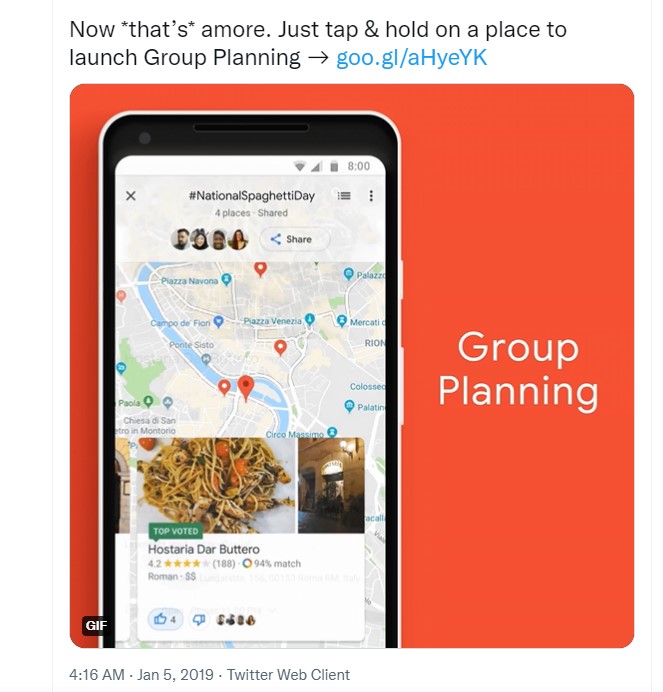
LinkedIn is known as the primary social networking site for professionals. It can be used to keep clients informed about your company, recruit new team members, and interact with industry partners. Because it is a professional network, it is the best choice for Business to Business (B2B) social media marketing.
Example: Intel Corporation
‘This LinkedIn ad example is a sponsored content ad with a carousel. These are among the best ad formats for those just starting up with LinkedIn for their business. The comic strip-like carousel used by Intel would catch the eye of any user, let alone their target audience, which consists of IT professionals. The ad copy does a good job in understanding the audience and listing the benefits of the product (see: “business-class PC,” and “boost productivity”).’ (Quadros, 2021)

Instagram is a photo-sharing platform that works well with any visual content. However, it is not a text-heavy platform and does not enable links within postings. Instagram is the ideal social media platform for businesses to share photographs and videos with their customers.
Nonetheless, the platform is a useful tool for establishing your brand's identity. Suppose you are a Business to consumer (B2C) business. In that case, you may use it to publish images of your items in action and urge your followers to do the same, resulting in user-generated content that you can then re-post in your feed. You can use it to share behind-the-scenes images of your firm and workplace if you are a B2B company.
Example: Warby Parker
Warby Parker has a head start on the competition. They have a wide range of glasses, sunglasses, and contact lenses to choose from. They have been using Instagram to share artistic photos. This business understands the value of a hashtag. They have also run a number of successful Instagram promotions.
#WarbyBarker, which features dogs wearing their spectacles, is one of them. They do not all involve puppies with glasses, though. They also provide stories about people who wear their spectacles and are quite inspirational.
The campaign is called #WearingWarby, and here is an example of one of the posts they have posted.
TikTok
It is a good platform for giving users a behind-the-scenes look at your brand and participating in viral trends. It lets people share short movies for a variety of reasons. Viral dances, brief instructions, and comedy kits are all examples of short videos. You can utilise TikTok's advertising services to advertise your business in addition to posting videos about it.
Example: Gymshark
Gymshark is one of TikTok's most popular fitness brands, with over 2 million followers in just six months. Gymshark caters to fitness enthusiasts by presenting training challenges, inspiring health journeys, and relevant fitness comedy that makes going to the gym less frightening.
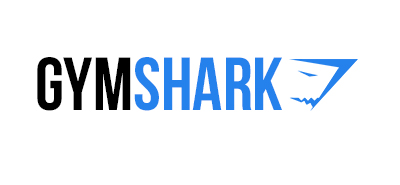
EDM marketing
Electronic Direct Mail marketing, or EDM marketing, is a marketing strategy that focuses on creating relationships with a broad group of potential customers to enhance overall sales. EDM marketing is about developing a list of potential clients you can contact by delivering them interesting email messages. It enables you to communicate directly with your potential and existing customers to promote brand loyalty, build relationships, and drive conversions.
Example: Starbucks
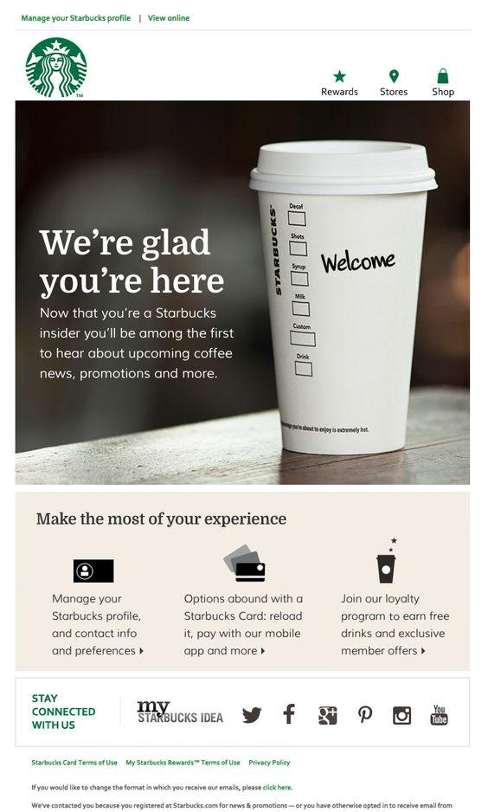
Even though social media marketing is very popular, traditional marketing should still be considered relevant. With the ever-increasing desire to leave the digital world, traditional marketing continues to play a vital role in people's lives. Let us now look at some of the traditional types of marketing.
Traditional marketing
Billboards, newspaper advertisements, television ads, and other traditional media allow firms to reach a broad target audience. Due to its broad targeting and advertising channels, traditional media tends to be more expensive than new media.
Printed media
Print media marketing involves promoting products and services through newspapers, magazines, and other forms of print media. On the one hand, it is a mass-marketing method since businesses may reach a large number of people through printed advertisements, regardless of their interest in the product or service. On the other hand, it is regarded as a niche-marketing technique in which a certain group of clients can be addressed or targeted, such as publications devoted to fashion or ladies or luxury car magazines.
Example: Volkswagen

‘In 1960, VW sold its trustworthy design to the world by labelling a car a lemon, the word commonly used to describe production defects. It had a minor default, not noticeable to the eye, but it was taken off the market. Well, fast forward almost 60 years and a Beetle is, once more, taken off the market. This time it is not for any default but simply because tastes have changed. And so, it is a 'lime' and worthy of a print adverts roundup.’ (68 brilliant print adverts, 2021)
Out of home marketing
Outdoor media, often known as out-of-home marketing, is a marketing and advertising method used to contact clients and audiences outside of their homes. It is a visual advertising media, and it can be viewed from the street. This marketing technique incorporates several mediums such as billboards, signs, street furniture such as benches or bus shelters, public transportation such as bus, train, or airport, venues such as stadiums or shopping malls, or cinemas.
Fun fact: KitKat
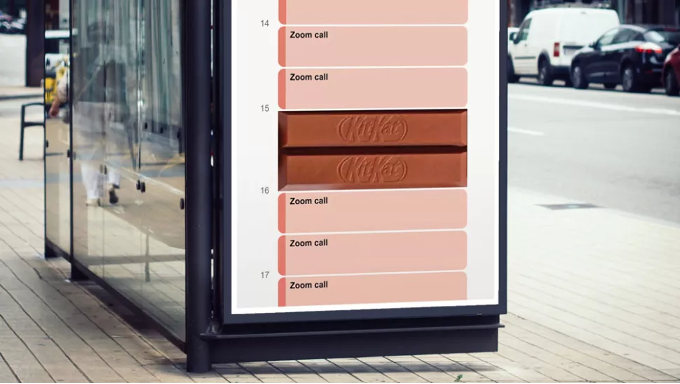
'Have a break, 'Have a Kit-Kat.' is one of the most well-known and long-running advertising slogans in the world, with millions of people knowing and quoting it. And a new advertisement has been made that plays on that idea by putting it into the modern workplace. The commercial depicts a daily schedule dominated by Zoom meetings, with a Kit-Kat duo blocking out two spots in the middle at 3 p.m. It is straightforward, relevant, and entirely consistent with the brand.
Broadcasting marketing
Several broadcast marketing platforms such as radio and television are still in high demand in traditional marketing. Businesses may reach a significant number of people in a short amount of time and increase brand awareness by using broadcast marketing media. Different marketers or advertisers may develop better and more compelling ads using television because televisions allow for the visual display of products and explanations of how they work.
Fun ads: Television ads
Have a look at a few of the best New Zealand TV ads of all time.
KPIs (Key Performance Indicators) are quantitative metrics used to assess a marketing effort's success. They are useful tools for making decisions and demonstrating the value of your marketing investments. As a result, after creating and implementing a marketing strategy, the last stage is to assess its effectiveness. Tracking marketing KPIs is essential for fine-tuning your marketing strategies. Using the correct marketing KPIs allows you to assess the efficacy of your marketing efforts and implement your strategy over time. Let us now look at some of the online KPI’s you should be tracking.
Marketing return on investment
Return on investment, or ROI, is a metric for determining how much income a marketing campaign generates compared to the costs of executing the campaign. The most crucial metric to track and evaluate is the return on investment. While ROI is a significant and important KPI for your marketing, it can be difficult to calculate in some cases, such as when a client views an ad but does not click, then visits your site later.
The total sales and marketing expense required to acquire a new client is called customer acquisition cost. All programs and marketing expenses, salaries, commissions, technology, software, and any overhead related to a prospect client becoming a customer are included.
Customer lifetime value (LTV)
Your customer lifetime value (LTV) determines the average customer's long-term (or lifetime) value. Calculating the average lifetime value of customers can assist your business in developing better marketing budgets and determining a realistic cost per lead.

Digital marketing ROI
To evaluate your monthly and annual success, you must calculate your digital marketing return on investment. The capacity to start preparing strategies and budgets for upcoming planning periods is also critical. You do not want to keep increasing your marketing budget for an activity costing your company money. So, regardless of which marketing strategy your company employs, the return on investment will influence how you go in the future.
Lead-to-customer ratio
The sales represent the number of potential clients who become sales prospects, leading to customer ratio. It is a good measure of how effective your sales force is with their present resources; with this information, you can assist them in realising their maximum potential. This can compare the efficacy of various marketing channels used by a company. In most cases, the lead to customer is calculated weekly or monthly.
Landing page conversion rates
A landing page that does not produce leads is worthless, regardless of how much traffic it receives or how well-designed it is. If your landing page receives a lot of traffic but has a low conversion rate, it is a red flag that something needs to be changed on the page.
Organic traffic
The amount of organic traffic to your website is tracked by your organic traffic. Social media paid marketing and organic sources may generate visitors to your site. Organic traffic is valuable because it is effectively free.
Social media traffic
Many businesses are hesitant to include social media in their digital marketing strategy. It is not always thought of as a technique to generate leads or a tool for your audience to interact with you. However, social media is critical to the success of any campaign. Social media channels are excellent for informing, generating buzz, and increasing awareness among your target audience.
Mobile traffic
With so many individuals browsing the web exclusively on their smartphones and other devices and Google favouring mobile-friendly sites, you need to know how your visitors access your site via their mobile devices.
Keep a list of your KPI outcomes; whether you use a spreadsheet, word document, or other technology, this is likely the most important part of developing your marketing strategy. You can evaluate what is working and alter your plan accordingly if you keep track of your KPIs over time.
Digital marketing has exploded in popularity in the current digital era among businesses seeking to succeed online in a competitive global market. Although digital marketing in New Zealand is a relatively new business, there are many growth opportunities.
Have a look following information in the slider for an insight into digital marketing in New Zealand during 2020.
Digital marketing offers businesses a wide range of options for long-term success, but it is up to you to take advantage of them.
Brief

A high-profile t-shirt brand is looking to improve its influence on its target audience within New Zealand.
Create drafts for at least two social media posts based on your target audience research. Using the social media platform, create finished design visuals to show how the post will display online.
Create mock-ups or actual profiles for the t-shirt brand on at least two social media platforms. Include text and images to communicate the brand’s USP, values and culture.

